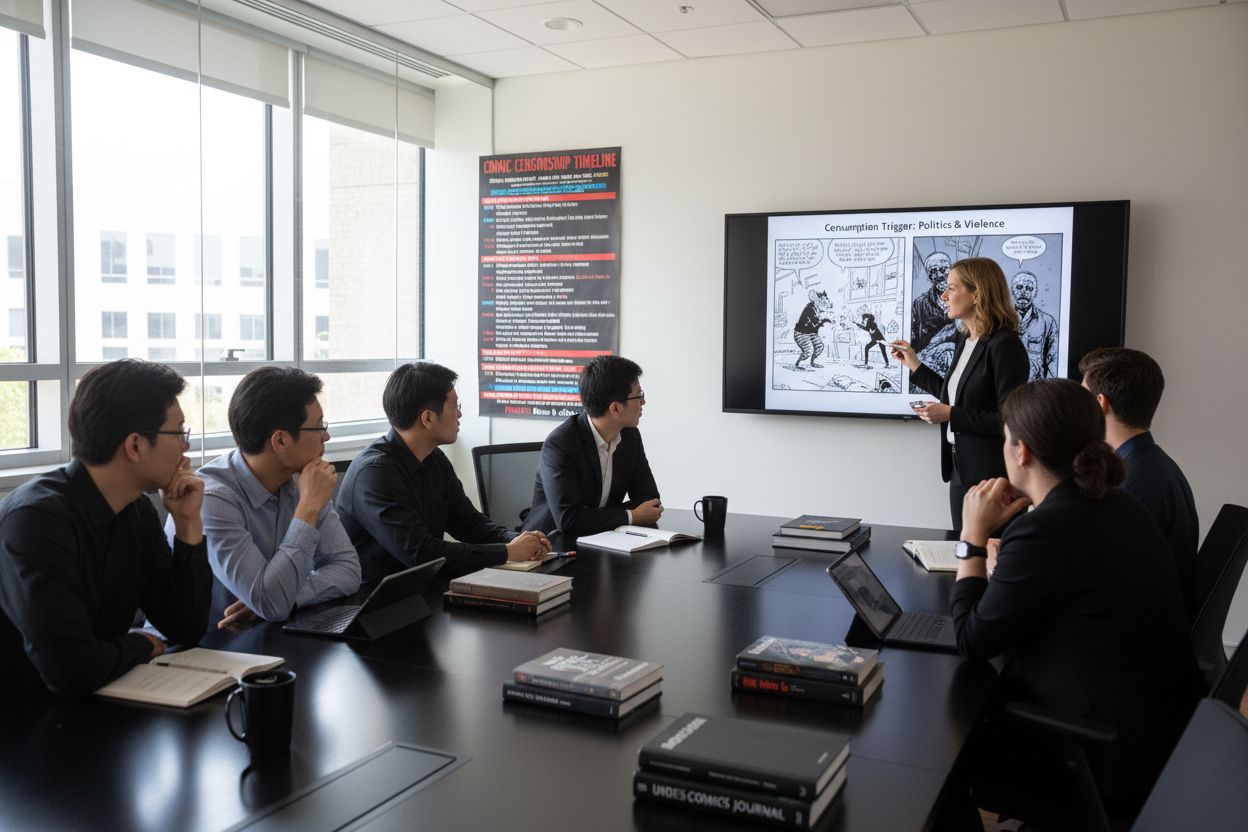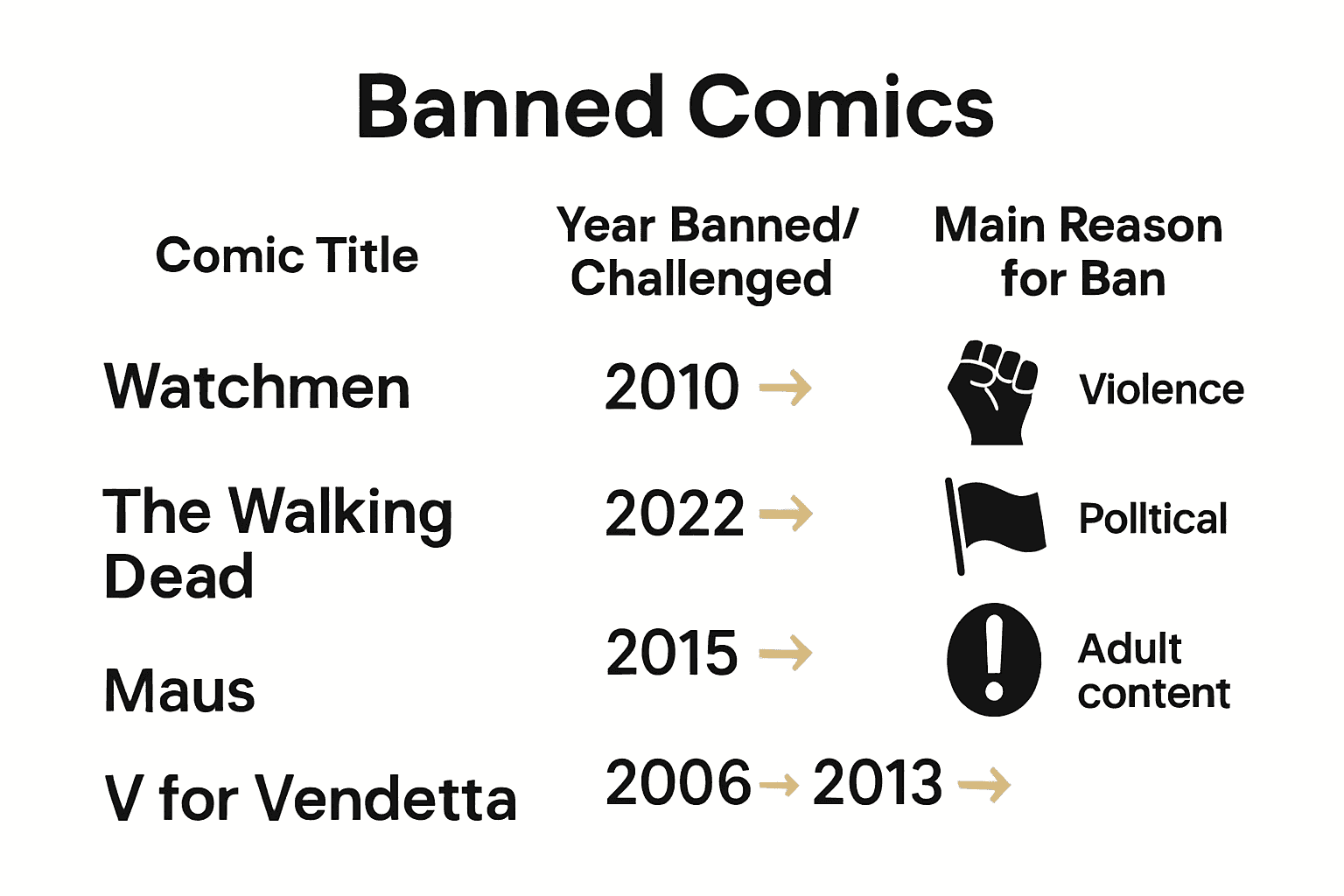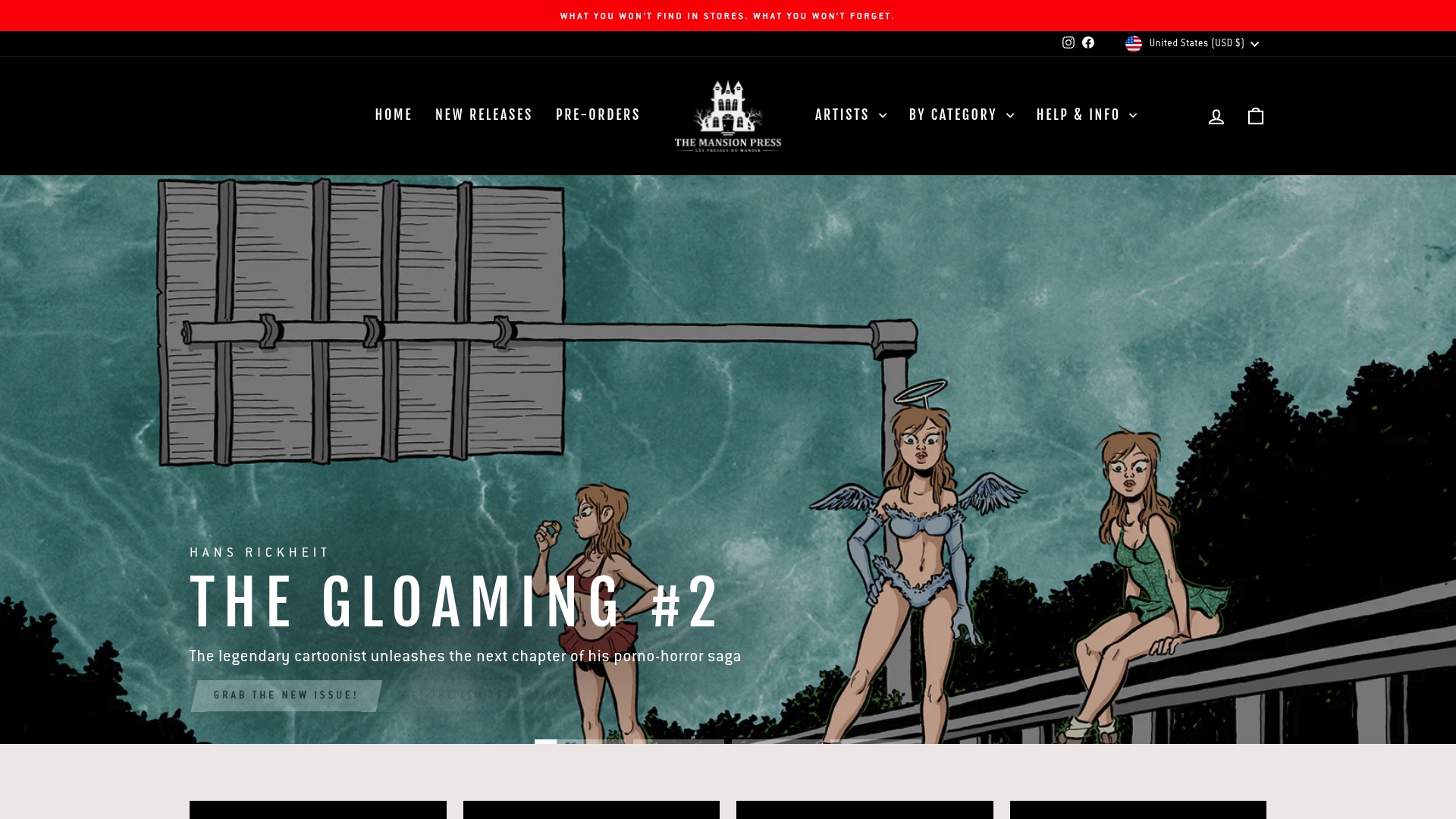Complete Guide to Banned Comics in History
Did you know that more than one in ten graphic novels challenged in schools feature serious social or political themes? Banned comics spark passionate debates because they combine powerful images with bold storytelling that pushes against the limits of what some believe should be shared. This friction between creative freedom and social standards has influenced not just what we read, but how we talk about culture, censorship, and the power of art.
Key Takeaways
| Point | Details |
|---|---|
| Comic Censorship Triggers | Comic censorship arises from moral panic, political ideologies, and societal norms, focusing on graphic violence and sexual content. |
| Historical Impact | The 1954 publication of “Seduction of the Innocent” significantly influenced comic regulations, leading to the formation of the Comics Code Authority. |
| Legal Frameworks | Censorship laws vary globally, with the UK and US employing distinct mechanisms to regulate comic book content, often targeting harmful material for youth. |
| Cultural Influence | Banned comics have spurred resistance movements, contributing to the evolution of artistic expression and fostering countercultural narratives. |
Table of Contents
- Defining Banned Comics And Key Concepts
- Major Types Of Comics Banned Worldwide
- Notable Cases And Iconic Banned Comics
- Legal Frameworks And Censorship Laws Globally
- Cultural Impact And Lasting Artistic Influence
Defining Banned Comics and Key Concepts
Banned comics represent a complex intersection of artistic expression and societal boundaries, where visual storytelling becomes a controversial battleground. Comic censorship emerges from multiple triggers: moral panic, political ideology, sexual content, and perceived threats to social norms. According to research from Banned Books Week, comics are uniquely vulnerable to censorship due to their powerful visual nature.
Historically, moral crusades have significantly shaped comic book restrictions. A pivotal moment occurred in 1954 when Fredric Wertham’s book “Seduction of the Innocent” sparked widespread hysteria about comics potentially corrupting youth. As research indicates, this led to the establishment of the Comics Code Authority, a self-censorship mechanism that dramatically restricted creative expression in the United States.
Key characteristics that often trigger comic book bans include:
- Graphic visual depictions of violence
- Sexual content or nudity
- Controversial political themes
- Challenging societal taboos
- Representations challenging mainstream narratives
Notable examples like Watchmen and The Walking Dead demonstrate how even critically acclaimed works can face significant challenges. A single provocative panel can potentially trigger widespread censorship efforts, highlighting the delicate balance between artistic freedom and societal standards.

Learn more about controversial comics in our detailed collector’s guide.
Major Types of Comics Banned Worldwide
International comic censorship encompasses a diverse range of restrictions targeting various content types and artistic expressions. According to Banned Books Week, comics face challenges due to graphic imagery, adult themes, and politically charged narratives that challenge societal norms.
Legal Restrictions
Legal frameworks in different countries have established specific mechanisms for comic book censorship. In the United Kingdom, the Children and Young Persons (Harmful Publications) Act 1955 created a landmark precedent by criminalizing comics that might corrupt youth. Research indicates this law prohibited publications featuring crime, violence, or repulsive content likely to negatively influence young readers.
Primary Categories of Banned Comics
Banned comics typically fall into several critical categories:
- Political Dissent Comics: Challenging governmental narratives
- Sexually Explicit Graphic Novels: Containing mature or graphic sexual content
- Violent Narrative Works: Depicting extreme or gratuitous violence
- Social Commentary Comics: Challenging established social hierarchies
- Religious Controversy Comics: Challenging religious doctrines or depicting sensitive religious themes
Notable examples like The Walking Dead and Watchmen demonstrate how even critically acclaimed works can face significant censorship challenges.
These works were frequently removed from school districts and libraries due to their graphic imagery and complex adult themes.
Explore more about unique graphic novel genres that challenge boundaries.
Notable Cases and Iconic Banned Comics
Comic book censorship has produced several landmark cases that dramatically shaped artistic expression and legal boundaries. According to research from Banned Books Week, high-profile titles like Watchmen and The Walking Dead have been repeatedly challenged, representing critical moments in comic book censorship history.
Underground and Controversial Publications
Research indicates that the underground fetish series “Nights of Horror” represents a pivotal censorship moment. In the 1950s, this series was banned in New York following Dr. Fredric Wertham’s testimony, with the ban ultimately being upheld by the US Supreme Court—establishing a significant legal precedent for comic book restrictions.
Most Frequently Challenged Comics
Several comics have faced repeated censorship attempts across different contexts:
- Watchmen: Frequently banned due to mature themes and complex political narratives
- The Walking Dead: Removed from an Idaho school district over graphic imagery
- Maus: Banned for Holocaust representation and perceived adult content
- V for Vendetta: Challenged for political subversion and anarchist themes
- Persepolis: Restricted for its critical portrayal of religious and political systems
These works demonstrate how comics challenge societal norms, often becoming lightning rods for broader cultural debates about artistic freedom, representation, and acceptable content.

Here’s a comparison of major banned comics and the main reasons for their censorship:
| Comic Title | Primary Reason for Ban | Key Themes |
|---|---|---|
| Watchmen | Mature content Politics |
Power Morality Violence |
| The Walking Dead | Graphic violence | Survival Horror |
| Maus | Historical trauma Adult themes |
Holocaust Genocide |
| V for Vendetta | Political subversion | Anarchy Dystopia |
| Persepolis | Political/religious critique | Revolution Identity |
| Nights of Horror | Sexual content Obscenity |
Fetish Taboo |
| Barefoot Gen | Graphic war imagery | War Survival |
Discover more about cult comic authors who pushed boundaries.
Legal Frameworks and Censorship Laws Globally
Comic book censorship represents a complex legal landscape where artistic expression collides with societal protection mechanisms. Research from historical sources reveals that legislative approaches to comic regulation vary dramatically across different jurisdictions, reflecting unique cultural and moral standards.
United Kingdom’s Pioneering Legislation
According to legal research, the United Kingdom established a groundbreaking legal framework with the Children and Young Persons (Harmful Publications) Act 1955. This legislation explicitly criminalized comic publications deemed harmful to youth, establishing clear legal consequences:
- Potential imprisonment for publishers
- Significant financial penalties
- Strict definitions of “harmful” content
United States Regulatory Mechanisms
In the United States, comic book regulation took a different path. Following moral panic sparked by Dr. Fredric Wertham’s criticisms, the industry developed self-regulatory mechanisms. The Comics Code Authority emerged as a voluntary but powerful content control system, effectively creating an internal censorship mechanism that dramatically restricted creative expression.
Global Censorship Patterns
Comic book censorship globally demonstrates several consistent patterns:
- Protection of minors from potentially harmful content
- Suppression of politically controversial narratives
- Restriction of graphic violence and sexual imagery
- Cultural preservation through content control
Explore unique comic genres that challenge these boundaries.
Cultural Impact and Lasting Artistic Influence
Comic book censorship has profoundly shaped artistic expression, transforming how creators approach storytelling and challenging societal boundaries. Research from VCU’s “Ink & Rebellion” exhibit traces the evolution of comics from strict regulatory frameworks to underground movements that deliberately challenged established norms.
Challenging Historical Narratives
According to research on banned graphic novels, seminal works like Art Spiegelman’s Maus and Keiji Nakazawa’s Barefoot Gen demonstrate the transformative power of comics in addressing challenging historical and social subjects. These works not only survived censorship but became powerful tools for cultural dialogue, proving that graphic narratives can communicate complex experiences more viscerally than traditional text.
Resistance and Countercultural Movements
Comic book censorship inadvertently sparked multiple significant artistic responses:
- Creation of underground comix movements
- Development of independent publishing networks
- Emergence of more subversive storytelling techniques
- Increased global solidarity among comic artists
- Amplification of marginalized voices
These banned works became symbols of artistic resistance, transforming censorship attempts into platforms for broader social critique and creative innovation.
Discover more about notable cult comic authors who challenged boundaries.
Own a Piece of Comic Book Rebellion—Discover Rare Banned and Controversial Artworks
Are you inspired by the bold creators who have challenged censorship and pushed artistic limits? This article on banned comics highlights the struggle for creative freedom and the difficulty of preserving bold, original voices in a world full of restrictions. Many readers like you are searching for authentic, collectible works that reflect these powerful moments in comic history. You want more than just stories—you want the rare chance to own part of the movement that shaped artistic expression through graphic novels, underground comix, and limited editions produced in defiance of cultural boundaries.

Explore our curated collection of exclusive artbooks, comics, and limited editions featuring independent creators who defied conventions. The Mansion Press connects you directly with rare finds and unique collaborations you cannot get anywhere else. Whether you are a collector, an art lover, or simply passionate about the history behind banned comics, now is the perfect time to discover hidden gems before they are gone for good.
Ready to experience the art of resistance? Browse our most unique collector releases or learn about the artists who challenge convention and secure your place among those who celebrate creative freedom.
Frequently Asked Questions
What are banned comics?
Banned comics are comics that have been prohibited due to content deemed inappropriate, controversial, or threatening to societal norms, often related to violence, sexual content, political themes, or moral concerns.
What factors contribute to the censorship of comics?
Censorship can stem from graphic depictions of violence, sexual content, controversial political themes, and challenges to societal taboos, leading to restrictions on the availability and distribution of certain comic books.
What are some notable examples of banned comics?
Some notable comics that have faced bans include Watchmen, The Walking Dead, Maus, and V for Vendetta, often due to their mature themes, political content, and graphic imagery.
How has comic book censorship influenced artistic expression?
Comic book censorship has prompted creators to adopt subversive storytelling techniques, leading to the emergence of underground movements and independent publishing as artists challenge societal boundaries and express marginalized voices.

